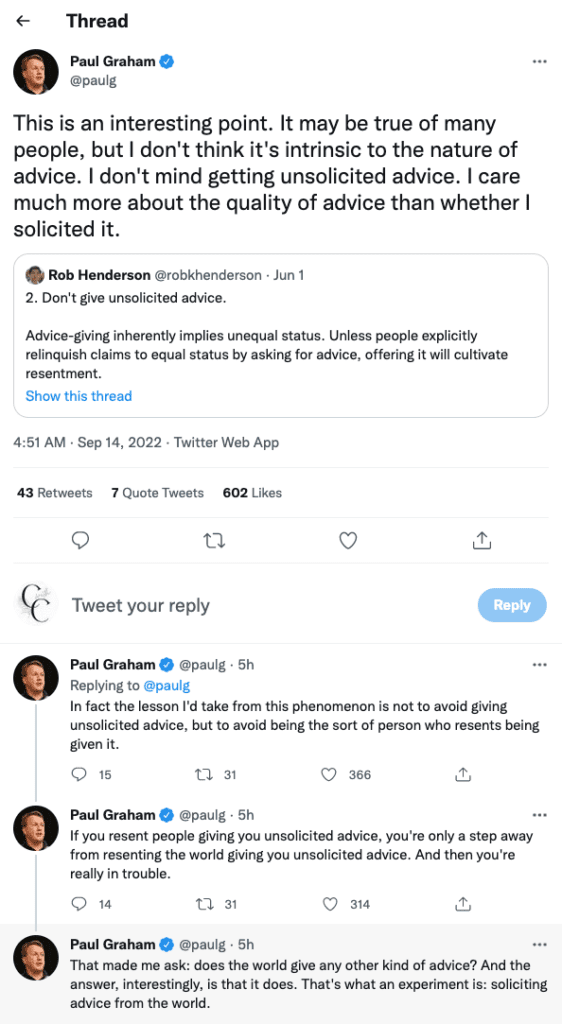I recently read a thread on twitter between Paul Graham and Rob Henderson (screenshot below), that got me thinking about the topic of advice. The gist of the thread is that Rob posted something telling people to never give unsolicited advice. Paul then replied that it’s not that unsolicited advice shouldn’t be given, but that people receiving that advice shouldn’t resent it. As both a startup leader and entrepreneur, I’ve been given lots of unsolicited advice over the years. This guide is based on that experience. It is also how I both assess advice and decide if it’s something I actually want to implement in my own life.

Is unsolicited advice inherently wrong?
Before diving into the how of assessing advice, I want to first start by exploring if unsolicited advice is really such a bad thing. My mother is the queen of giving unsolicited advice. Growing up, it used to drive me nuts that she would always share her opinions with me, unprompted. The older I’ve gotten, the more I’ve realized that it’s much more difficult to try to control the advice that is being given to you. Especially when that advice is from your mom. Instead, it’s much easier to control how you respond to the advice that is being presented.
That said, one layer that is missing from this twitter exchange is the intention behind the advice being given. I don’t think that all unsolicited advice is inherently wrong. I know that my mom was usually offering her advice from a place of love. However, I do think that it’s important for anyone considering giving unsolicited advice, to check in with what their intention is before giving that advice.
Want more content like this? Sign up for our emails below:
How to give intentional unsolicited advice.
I could write (and probably will!) an entire blog post just on how to give advice/feedback. For now, here’s a quick primer on how to give intentional unsolicited advice:
- Assess where the advice is coming from. Are you judging the person you’re about to give advice to? Do you feel like you know the right answer for how they should be doing something? Do you just have to share it? If the answer to these questions is yes, it can be a good idea to pause before giving the advice. It’s also a good time to assess some of your assumptions about the situation. In Conscious Leadership, the thought of knowing the right answer is a big clue that you are below the line. This means that you are committed to being right and are most likely wanting to share your advice from a place of fear. It’s a good time to ask yourself if you’re willing to shift above the line and approach the subject from a place of trust and openness.
- If the answer to the questions above is no, ask yourself if you’re giving this advice with an open hand. Meaning, are you recognizing that this advice is coming from your own experience and you may be wrong about this particular situation? If the answer is no, you may want to consider the steps above to shift from below the line to above the line.
- If you answered yes to the above questions, amazing! It seems your intention behind the advice is clear and you’re ready to approach the person. It is always a best practice to ask the person whom you are wanting to give the advice to if they would like your advice on this particular topic. At this time, they could say no and you’ll need to be OK with walking away without having expressed your opinion. If you’re truly above the line, this will feel OK for you as you are not committed to being right about your advice. If, however, this doesn’t feel good for you, it might be a clue to do some of your own work on why it felt so important for you to share this advice.
- After the person says yes, state that this advice is based on your own experience. Use language such as, “in my experience…” or “when I was in a similar situation, here’s what I did…” Make sure you share details about how your experience may have differed. This ensures that the person can properly assess the advice you’re offering.
- Let it go. Sometimes, we can think we’re offering advice from a place of love, but realize after we’ve given the advice that we’re obsessing over whether or not it was actually taken. Again, this can be a clue that we weren’t really offering that advice with an open hand. As a next step, we may need to do some of our own inner work on why we feel so committed to being right about this situation.

How to assess unsolicited advice.
While the process I’ve outlined above is ideal, the reality is that most people won’t have taken the steps above. In my experience, a lot of advice comes from a place of fear. Alternatively, it comes from people who are projecting their own insecurities onto you. In the steps I outline below, it’s important to check in with the intention behind the advice. This will allow you to properly assess what’s being shared with you:
- Ask yourself if this advice aligns with how you want to feel. Sometimes, we receive advice from people assuming that we want the same outcome as they do in a particular situation. For example, someone may give you advice on how to run your business. This person might assume that your goal is to make as much money as quickly as possible. They wanted to feel successful and powerful in running their business and assume that you do, too. If your goal is actually to start a business to have more freedom in your schedule, this advice may not align with the goal you have for yourself. If you want to feel calm and free while running your business, you realize that you have a completely different outcome in mind from the person offering you advice.
- Is this person knowledgable in this area? People often like to think of themselves as experts in all areas. Remember to question what someone’s credentials are before taking their advice on a certain topic. If Aunt Jane has never used social media, she’s probably not the best person to take advice from on how to optimize your Instagram.
- Does this person have similar values to me? Similar to the first point, it’s important to check in on what the person offering their advice values. If they value fame while you value fostering community, there will most likely be a disconnect between the advice they offer and what you actually want to do.
- Does this person have more information than I do or are they closer to the problem? This is a good one for bosses and employees to work through. If your boss is giving you advice in an area that you have more context on, it’s probably a good idea to pause before taking their advice. Conversely, if you’re a manager and you’re wanting to give advice to your employee, ask yourself this question before proceeding.
- Is this person offering their opinion while recognizing they could be wrong? If advice that’s being given feels like a command or is laced with words like “you’ll be sorry if you don’t do this,” it’s probably a clue that the person offering the advice is projecting their own stuff onto you. If this happens, make sure that the answers to the above questions feel good before proceeding.
What if I feel like I have to take the advice being offered?
I think it’s important to acknowledge how hard this process can be for those of us who are people-pleasers or who know that we have a tendency to people-please (especially when under stress). In a lot of work environments, advice is being given by those in positions of power on a regular basis. Most of the time, that advice is being hurled out at such a fast pace. Because of this, it can feel impossible for employees to stop and assess the advice. It can feel like in order to succeed, there isn’t an option to turn down the advice. This is why it’s so crucial for those in leadership positions to give intentional advice. It’s also why it’s important to clarify to our employees when something is advice vs. a directive.
Conversely, if you’re an employee being given advice by your boss and you’re unclear if it’s advice vs. a directive, just ask! Most of the time, those of use in leadership positions aren’t even sure of the answer until you ask. It can be a great opportunity to manage up. Also, it can help your boss to clarify and improve their communication style moving forward.
So back to those tweets…
Should you avoid giving unsolicited advice? I think the answer is a resounding no. If you’ve followed the steps I’ve outlined above, go right ahead! Again, remember to be OK if the answer you get when asking to give advice is no.
And what about avoiding being a person who resents receiving unsolicited advice? Well, I think the key here is to avoid resentment more broadly. As Brené Brown writes in her book, Atlas of the Heart:
“Resentment is the feeling of frustration, judgment, anger, ‘better than,’ and/or hidden envy related to perceived unfairness or injustice. It’s an emotion that we often experience when we fail to set boundaries or ask for what we need, or when expectations let us down because they were based on things we can’t control, like what other people think, what they feel, or how they’re going to react.”
from Brené Brown’s Atlas of the heart
To avoid resentment we must be clear on our own boundaries and communicate them to the other person. Remember, you never have to take someone’s advice just because it’s offered to you. You are also totally allowed to say the following. “You know what, thanks for that feedback but I’m actually not looking for advice on this topic right now.” When we don’t do this, we start to feel resentful because we’ve failed to communicate our boundaries. Maybe instead of advice, we’re in need of a little support or encouragement.
Learning to give and receive better advice
At the end of the day, the best way to both give and receive better advice is to be clear. Clear on your intentions for giving advice. And, clear on your boundaries around receiving advice. While you cannot control how and when people decide to give you unsolicited advice, you can control how to assess and implement the advice being given.
If this is a topic that you find challenging, coaching can be a great way to practice both giving and receiving advice and feedback. Click here to learn more, or click the link below to sign up for a complimentary 30-minute consultation!


Summer is a coach, writer, speaker and the founder of Created with Confidence. When she’s not working with clients or spending time outdoors, her favorite thing is helping ambitious humans succeed in following their dreams.

[…] and craft a specific request when giving and receiving feedback. They can also help you to assess the feedback that’s given to you so you can decide whether or not you want to incorporate it and how to move […]